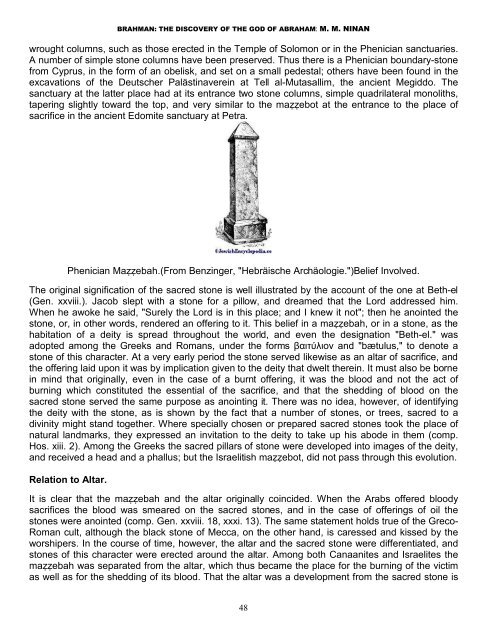You also want an ePaper? Increase the reach of your titles
YUMPU automatically turns print PDFs into web optimized ePapers that Google loves.
BRAHMAN: THE DISCOVERY OF THE GOD OF ABRAHAM: M. M. NINAN<br />
wrought columns, such as those erected in the Temple of Solomon or in the Phenician sanctuaries.<br />
A number of simple stone columns have been preserved. Thus there is a Phenician boundary-stone<br />
from Cyprus, in the form of an obelisk, and set on a small pedestal; others have been found in the<br />
excavations of the Deutscher Palästinaverein at Tell al-Mutasallim, the ancient Megiddo. The<br />
sanctuary at the latter place had at its entrance two stone columns, simple quadrilateral monoliths,<br />
tapering slightly toward the top, and very similar to the maẓẓebot at the entrance to the place of<br />
sacrifice in the ancient Edomite sanctuary at Petra.<br />
Phenician Maẓẓebah.(From Benzinger, "Hebräische Archäologie.")Belief Involved.<br />
The original signification of the sacred stone is well illustrated by the account of the one at Beth-el<br />
(Gen. xxviii.). Jacob slept with a stone for a pillow, and dreamed that the Lord addressed him.<br />
When he awoke he said, "Surely the Lord is in this place; and I knew it not"; then he anointed the<br />
stone, or, in other words, rendered an offering to it. This belief in a maẓẓebah, or in a stone, as the<br />
habitation of a deity is spread throughout the world, and even the designation "Beth-el." was<br />
adopted among the Greeks and Romans, under the forms βαιτύλιον and "bætulus," to denote a<br />
stone of this character. At a very early period the stone served likewise as an altar of sacrifice, and<br />
the offering laid upon it was by implication given to the deity that dwelt therein. It must also be borne<br />
in mind that originally, even in the case of a burnt offering, it was the blood and not the act of<br />
burning which constituted the essential of the sacrifice, and that the shedding of blood on the<br />
sacred stone served the same purpose as anointing it. There was no idea, however, of identifying<br />
the deity with the stone, as is shown by the fact that a number of stones, or trees, sacred to a<br />
divinity might stand together. Where specially chosen or prepared sacred stones took the place of<br />
natural landmarks, they expressed an invitation to the deity to take up his abode in them (comp.<br />
Hos. xiii. 2). Among the Greeks the sacred pillars of stone were developed into images of the deity,<br />
and received a head and a phallus; but the Israelitish maẓẓebot, did not pass through this evolution.<br />
Relation to Altar.<br />
It is clear that the maẓẓebah and the altar originally coincided. When the Arabs offered bloody<br />
sacrifices the blood was smeared on the sacred stones, and in the case of offerings of oil the<br />
stones were anointed (comp. Gen. xxviii. 18, xxxi. 13). The same statement holds true of the Greco-<br />
Roman cult, although the black stone of Mecca, on the other hand, is caressed and kissed by the<br />
worshipers. In the course of time, however, the altar and the sacred stone were differentiated, and<br />
stones of this character were erected around the altar. Among both Canaanites and Israelites the<br />
maẓẓebah was separated from the altar, which thus became the place for the burning of the victim<br />
as well as for the shedding of its blood. That the altar was a development from the sacred stone is<br />
48


















